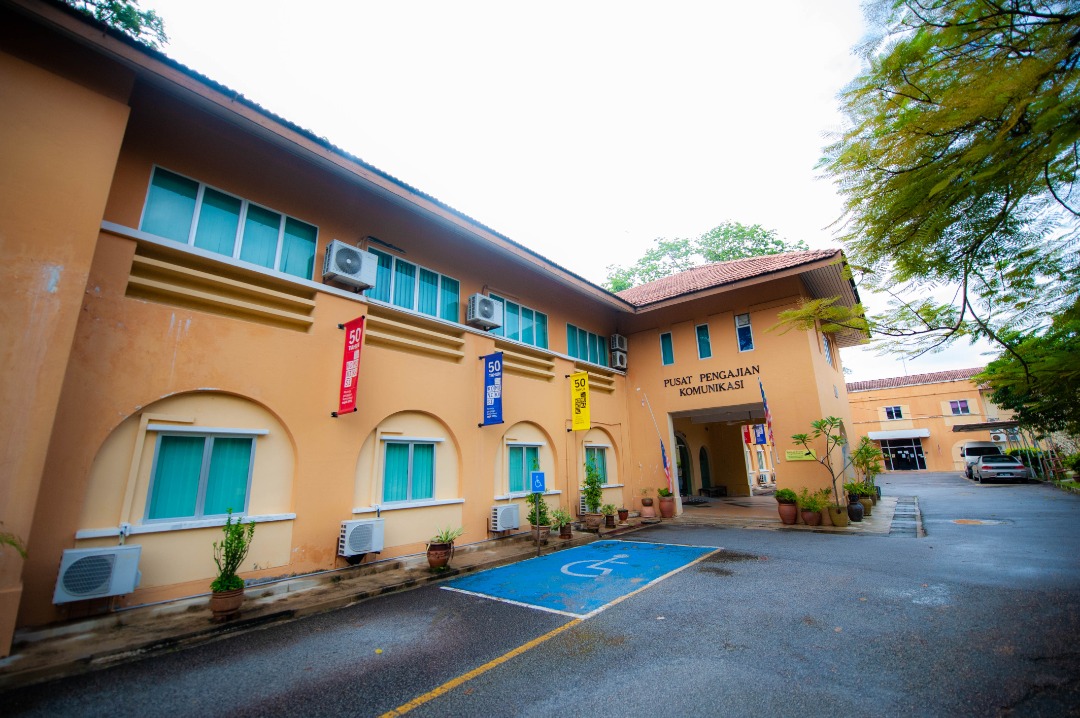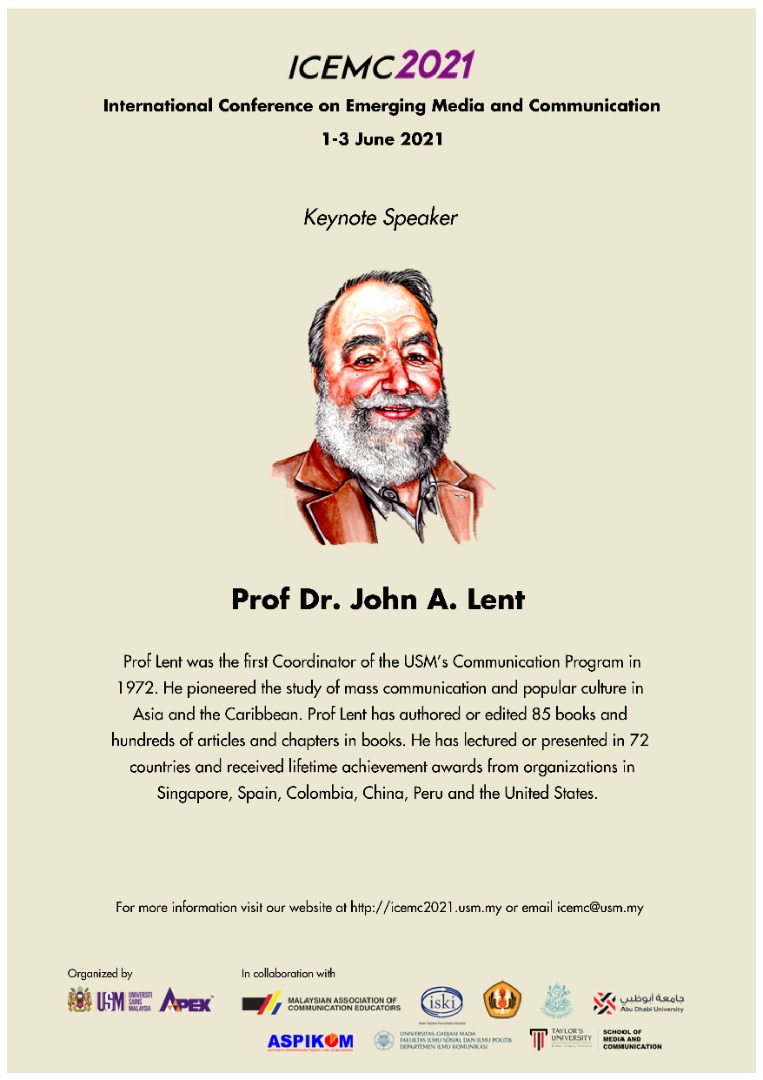CELEBRATING 50 YEARS OF COMMUNICATION STUDIES AT USM
Communication studies at the higher education level in Malaysia began in 1971 at Universiti Sains Malaysia (USM). The curriculum during its early days was mainly modelled after the American system, even though there was effort to embed the Rukun Negara principles into the programme, as told by Professor Dr. John Lent, the first coordinator of the USM communication studies programme.
USM PENANG, 5 July 2021 - Universiti Sains Malaysia’s (USM) School of Communication has successfully organised the International Conference of Emerging Media and Communication (ICEMC) 2021 from 1st to 3rd of June 2021.

The conference, held in conjunction with the 50th anniversary of the Communication programme at USM, witnessed the presence of the founder and coordinator of the first communication school in Malaysia in 1972, Professor Emeritus Dr. John A. Lent, as the conference keynote speaker.
According to the Dean of School of Communication, Dr. Nurzali Ismail, although still faced with issues relating to the COVID-19 pandemic, they did not lose their spirit in organising and celebrating the 50 years anniversary, thanks to the hard work put in by the organising committee led by conference convener, Associate Professor Dr. Juliana Abdul Wahab.
“This is an important milestone, not only for us in USM but also to others in the country. 50 years is not a short period of time, and to be able to reach this milestone since the humble beginning back in 1971 is really a huge achievement.
“At that time, I was told we only had small group of students taught by part-time lecturers and later with just a few full-time academic staff. Now we operate a full-fledge faculty offering academic programmes at the undergraduate and graduate levels,” said Nurzali, beaming with pride.
Nurzali added, fifty years on, without a doubt, communication studies in Malaysia has grown by leaps and bounds and, to a large extent, contributed to the growth of the nation.
“Many of the communication studies graduates have become prominent media practitioners, government officers, professionals, entrepreneurs and scholars,” he said.
According to Professor Emeritus Dr. John Lent, while he was finishing his Doctor of Philosophy (PhD) in 1972 at The University of Iowa, he was given an opportunity to help develop a communication programme, and that was when he came to Penang.

“I told the Dean, Professor Van Niel that I was at a loss as to how to start this programme; I had ideas but there really wasn’t much on the ground at the time.
“And so, we started teaching the courses that were already there. Van Niel wanted me to change it to meet the needs of Malaysia, and I asked him where do I find out about those and he said read the Rukun Negara,” said Lent.
It was also in 1972 at USM when he met his first batch of communication students and he was contemplating on what would he discuss with the students. He had to tell them about the reportage of events during that disruptive period, which were the Vietnam War, The Civil Rights Movements, The Revitalization of the Feminist Movements, The Continuing and Emerging Authoritarianism in Asia and the early aspects of Watergate in the United States.
“My new students must be told how mass media are structured, their missions, their biases and other issues. They must learn about the then current trends and problems of what was then termed the third world and also their mass communications.
“Afterall, Malaysia is part of the southern hemisphere and worldwide attention in 1972 was focused on this region’s communication systems and how they were being controlled and how they can be used for social change purposes,” he said.
Lent also mentioned that the high quality of students at USM led to the practice of free concepts of educating, particularly the two-way learning process between teacher and students.
He went on to say, “Never in my wildest dream 50 years ago could I have envisioned that what we started as a curriculum would develop into this. At the time, we were the only two faculty members teaching about eight courses that were very broadly defined. We had two batches of students, numbering at about 25 each.
“I could not have imagined at that time that the USM School of Communication would one day be offering undergraduate and postgraduate programmes, employing more that 30 faculty members and also making available a curriculum of 52 undergraduate courses,” he added.
According to Lent, to build all of that over the past five decades required much dedication, tenacity and hard work by many people, of which he thanked each and everyone of them today for their commitment to the USM School of Communication.
Lent’s impressive repertoire of his life’s work includes teaching Mass Communication from 1960-2011; the founder and director of the first mass communication school in Malaysia, USM (1972-1974); served on faculties at the West Virginia Institute of Technology, Syracuse University, University of Wyoming, Marshall University, University of Wisconsin-Eau Claire, Temple University and De La Salle College (Philippines); Visiting Professor at the Communication University of China Animation School, Beijing Film Academy-Qingdao, Nanjing Normal University, Shanghai University and Universiti Kebangsaan Malaysia. He was also the Rogers Distinguished Professor of Media Studies at the University of Western Ontario.
Text: Thigambarishini Gobi (intern)/Editing: Tan Ewe Hoe
-------------------------------------
Excerpts from The Birthing of USM's Communication Program by Prof. John A. Lent
https://www.southbound.com.my/Johnlent.html
“The campus was breathtaking in its beauty, surrounded by mountains and ocean, with sparse buildings in natural settings. Even then, it was a university in a garden although that phrase was not yet used. The drive from the small airport in Bayan Lepas was through coconut groves (the multinational factories which eventually destroyed that beauty were just arriving about that time) and George Town itself was quaint, exciting, and colorful, with its small buildings, plentiful street vendors dishing out unique and delicious cuisine, rambling E&O Hotel, The Esplanade, and encased by Penang Hill and the yet-unspoiled beaches of Batu Ferringhi.
When I came to USM, my duties as coordinator of the Communication Program, the first of its kind at the university-level in Malaysia, were to redesign the curriculum and teach half of the courses with Vincent Lowe, an instructor who had just received his MA in the United States. The Communication Program was started in 1971, with rather non-distinguishable courses, namely, Mass Communication, Journalism, Audio Visual Media, and Writing for Mass Media; all offered at levels “I” for second-year students and “II” for third-year students. Another course, Mass Media in Education and Development, was on the schedule when I began to teach. These were the courses the two of us shared in 1972. Prior to my arrival, the courses were taught by visiting lecturers from the media based in Kuala Lumpur and Singapore who flew in every week. Some were distinguished media practitioners working with the Asian Mass Communication and Information Centre (AMIC), UNESCO, National Broadcast Training Centre (NBTC), South East Asia Press Centre, CEPTA TV, etc. During my stint at USM, we maintained close liaison with these media leaders and others.
To redesign the communication curriculum was a formidable challenge. Whenever I told Dean Van Niel I did not feel I knew enough about Malaysia and its mass media to carry out the task adequately and appropriately, his reply was always “Read the Rukunegara.” But the National Ideology was vaguely stated and not of much specific help. Eventually, we did change the program, establishing an Introduction to Mass Communication course for first-year students, five others for the second-year (Communication Theory, Media and Society, Mass Media Production and Direction, Mass Media Reporting and Writing, and Communication and Culture), and six for third-year students (Communication Research and Methods, Mass Media [Advanced Production and Direction], Mass Media [Advanced Reporting], Comparative Media Systems, Development Communication, and International Communication). Second-year students were required to attend a one-week familiarization-with-media program in Kuala Lumpur, and during their long holiday, serve a six-week internship with Kuala Lumpur based media, four weeks of which were at NBTC. During the five-day field trips, when they were housed at Wisma Belia at $3 per night, students became acquainted first-hand with Radio Malaysia, Television Malaysia, Malay Mail, Bernama news service, Grants Advertising, Shell Oil public relations, NBTC, Department of Information, Filem Negara, Ogilvy, Benson & Mather, New Straits Times, and Utusan Melayu. The on-campus production courses were set for an entire morning once a week to allow students to follow through all stages of media work in sequence (from reporting to writing to editing or broadcasting).
The new curriculum was one to be proud of, even surpassing many longer-established undergraduate programs in the United States in its scope, rigor, and depth. The courses were oriented toward both research/theory and practice and were interdisciplinary in nature. They revolved around communication skills, humanistic approaches to communication, and development and international communication. The latter were especially appropriate at the time with Asian governments’ and NGOs’ emphasis on using communication for national development purposes. Development communication was the buzzword of the day.”
- Created on .
- Hits: 1719
